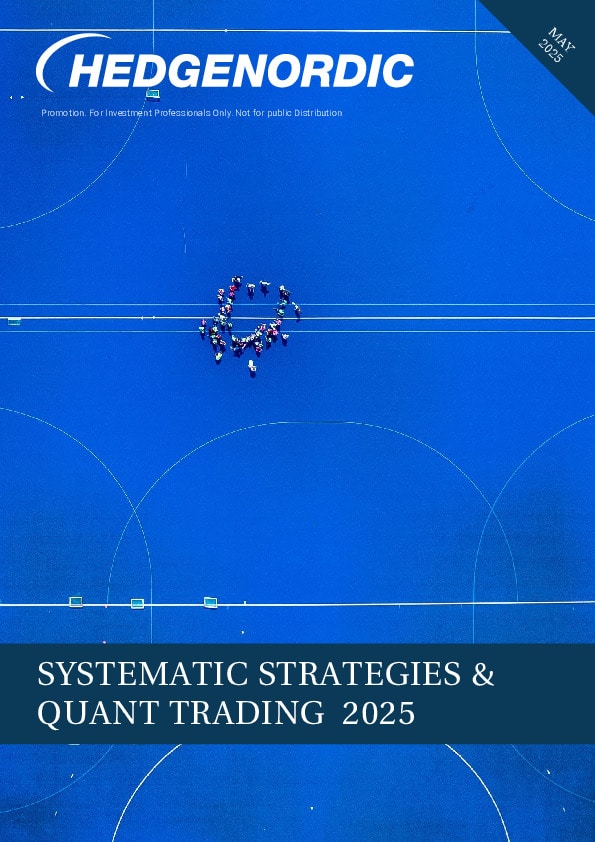HedgeNordic met with GreshamQuant Co-Heads; Dr Thomas Babbedge, Chief Scientist and Jonty Field, Chief Operating Officer, to discuss the role of capacity within ACAR, an alternative commodity CTA.
“In Astronomy the Goldilocks zone denotes the range of planetary orbits around a star where the temperature is not too hot and not too cold – instead it is ‘just right’ to allow liquid water and hence potentially life,” recounts Dr Babbedge, a former Astrophysicist. “For a CTA that ‘just right’ zone is about your choice of size and capacity – how many $s are you running and what implications that has in terms of the markets you can access meaningfully.”
“For a CTA that ‘just right’ zone is about your choice of size and capacity – how many $s are you running and what implications that has in terms of the markets you can access meaningfully.”
Capacity in financial futures measures the size of a market: how much risk is traded in a given future contract daily? How much risk can be traded without excessive market price impact? Capacity can also refer to inventory: How many contracts are outstanding? What is the open interest? What is the size of the roll market? In commodity markets, the financial contract’s capacity relates to the size of the underlying physical market: How much grain is produced and sold via futures? How much oil is bought and consumed via the futures market? There are two types of players in commodity markets: the physical players (hedgers) and the financial players (speculators), “The interaction between hedgers and speculators makes commodity markets so fascinating. Even for a specific futures contract, speculators may be trading the near expiry while hedgers may be trading the back of the curve,” explains Dr Babbedge. “To GreshamQuant, capacity is also a tool to enhance portfolio diversification, returns and long-term performance,” adds Field.
Optimizing Diversification
“Diversification is key to a CTA’s performance,” explains Babbedge. “Each individual futures market can yield a small profit but by allocating risk to uncorrelated markets, we are able to reduce overall portfolio volatility and increase Sharpe for our investors.” As importantly to our clients, diversification within the commodity markets also reduces ACAR’s correlations to other CTAs: “Most CTAs have correlation to the SG CTA index exceeding 80, ACAR’s correlation is around 25%,” says Field. “We trade very differently to other CTAs even at times of stress: just recently, following Trump’s liberation day, April 2025, Gresham’s ACAR strategy was up while most other CTAs were down meaningfully,” he adds. “This allows us to live side-by-side with big CTAs: we are providing risk exposure they do not offer,” he concludes.
Disciplined Hard Closes
Being able to maintain that diversity requires discipline in managing in-flows. “Usually, strategy’s capacity is limited by the risk it allocates to its biggest markets. ACAR’s capacity is limited by its smallest markets and our conviction to allocate meaningful risk to them,” explains Babbedge.
“Usually, strategy’s capacity is limited by the risk it allocates to its biggest markets. ACAR’s capacity is limited by its smallest markets and our conviction to allocate meaningful risk to them.”
“We plan inflows based on long term growth in our markets and we work in partnership with our existing client base to avoid compulsory redemption,” says Field. “During covid, liquidity in commodity markets exploded but we avoided taking capital to ensure we would not have to give it back,” recalls Babbedge. “We do not want to optimize capacity every 6 months because we are building long term partnerships with clients to align interests,” adds Field.
Market Selection
GreshamQuant select markets that are dominated by real world players such as consumers, producers, suppliers and hedgers, rather than speculators and investors. “Though these alternative markets can have enormous underlying physical markets, the futures that we trade can sometimes be smaller and less liquid than more widely traded futures. These markets are expected to exhibit inelastic demand and generate better trends than most futures markets,” explains Dr. Babbedge. “Even within an alternative futures market, oftentimes we will trade further out the curve where prices are less sensitive to news shocks and are driven by fundamental supply and demand, we find this often translates to stronger and slower trends,” points out Field.
Sizing Commodity Markets Evenly
Gresham’s ACAR strategy broadly aims to size risk evenly across markets because this aids diversification and an overall reduction in portfolio volatility. “Portfolio construction is based on a diversified set of risk factors deriving from the properties of markets so that they have equal opportunities to perform well. It is not based on backtests or lookbacks,” explains Babbedge.
“Portfolio construction is based on a diversified set of risk factors deriving from the properties of markets so that they have equal opportunities to perform well. It is not based on backtests or lookbacks.”
He gives an example of this principled approach: “When we started in 2017, European Carbon had a negative Sharpe lookback, but we still gave it a large allocation as it was a strong diversifier. It paid off handsomely as Carbon markets grew in both size and importance,” explains Babbedge.
Adding and Deleting Markets
Capacity is thus somewhat fluid and new markets can grow capacity over time, but markets are added for diversification rather than capacity per se. “Markets such as South African Richards Bay Coal were removed after they became less liquid. An extreme case was nature-based global voluntary carbon credits, which have gone from 100 to zero due to credibility concerns. Brokers share plenty of intelligence alerting us to potential liquidity issues, such as Black Sea Wheat, which we ceased trading after Russia invaded Ukraine,” says Babbedge. “Since we trade well over 150 markets, without one dominating risk, we can afford to be disciplined about removing markets that no longer meet the ACAR hypothesis,” explains Field, “it would not be existential if any one market disappeared.”
Execution & Trading Costs
Another barrier to entry to these markets is execution. Jonty Field was head of execution analytics in AHL and later was part of the growth of the algorithmic execution broker QB. “Execution of ACAR markets is ‘high touch’, requiring an extensive network of brokers. Gresham has traded commodities since the early 80s, and we rely on our brokers not only for trading but also for understanding other market participants. We also monitor change in market participants via Commitment of Traders reports,” he comments. “Trading Costs Analysis is crucial to us and understanding market participants is important in understanding slippage and how it changes during big market events.” GQ monitors slippage when CTAs are deleveraging. “Although there are more CTA participants, we have not noticed unusual slippage during deleveraging episodes.”
Chinese Futures
Commodities are usually a smaller component of alternative CTAs while ACAR trades commodities exclusively. “The Chinese market is commodity oriented, so we have a decent exposure to it, though we ensure that our risk exposure is at most 25%-30% of the book,” outlines Babbedge. “It is possible to obtain substantial diversification within the universe of Chinese futures, since they contain unique markets including green energy, feedstock chemicals and fertilizers that can have very different drivers,” he adds. Gresham access Chinese futures via onshore swaps to mitigate repatriation and political risks. “We have one of the largest swap capacities based on our long-term relationships,” says Field. As the Chinese economy grew, most Chinese futures markets have grown in capacity though there are always exceptions such as thermal coal that have become less liquid.
Looking Ahead
Tariffs and trade wars might shrink some markets, but others could grow. “Shifts in economic activity and global trade creates new opportunities,” explains Field, “Deglobalization creates more idiosyncratic, local rather than financialized markets.” Other trends such as the growth of AI, electrification and the green economy are other unique risk factors ACAR provides to client, “Trade wars, recessions, inflation and deflation can all be interesting times for us,” sums up Babbedge.
This article features in the “Systematic Strategies and Quant Trading” publication below:

